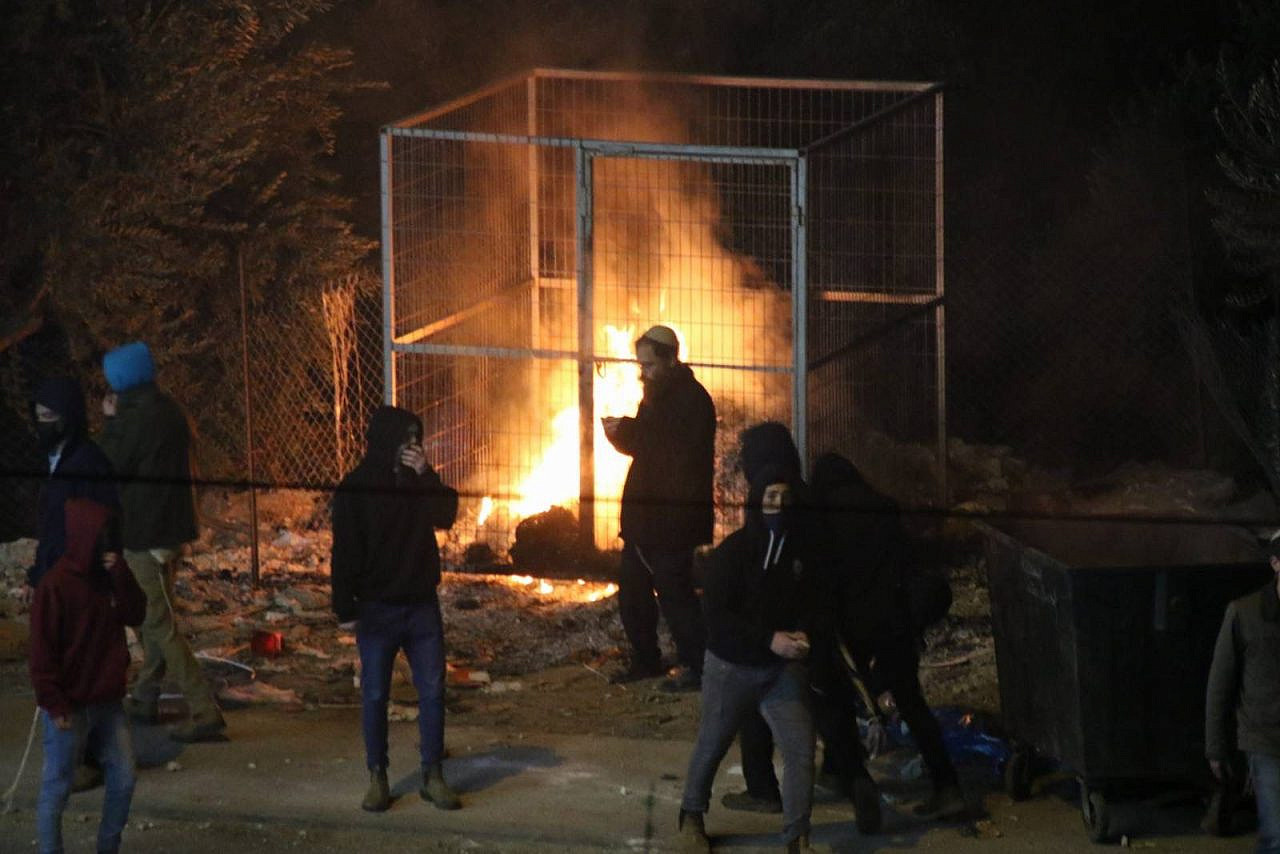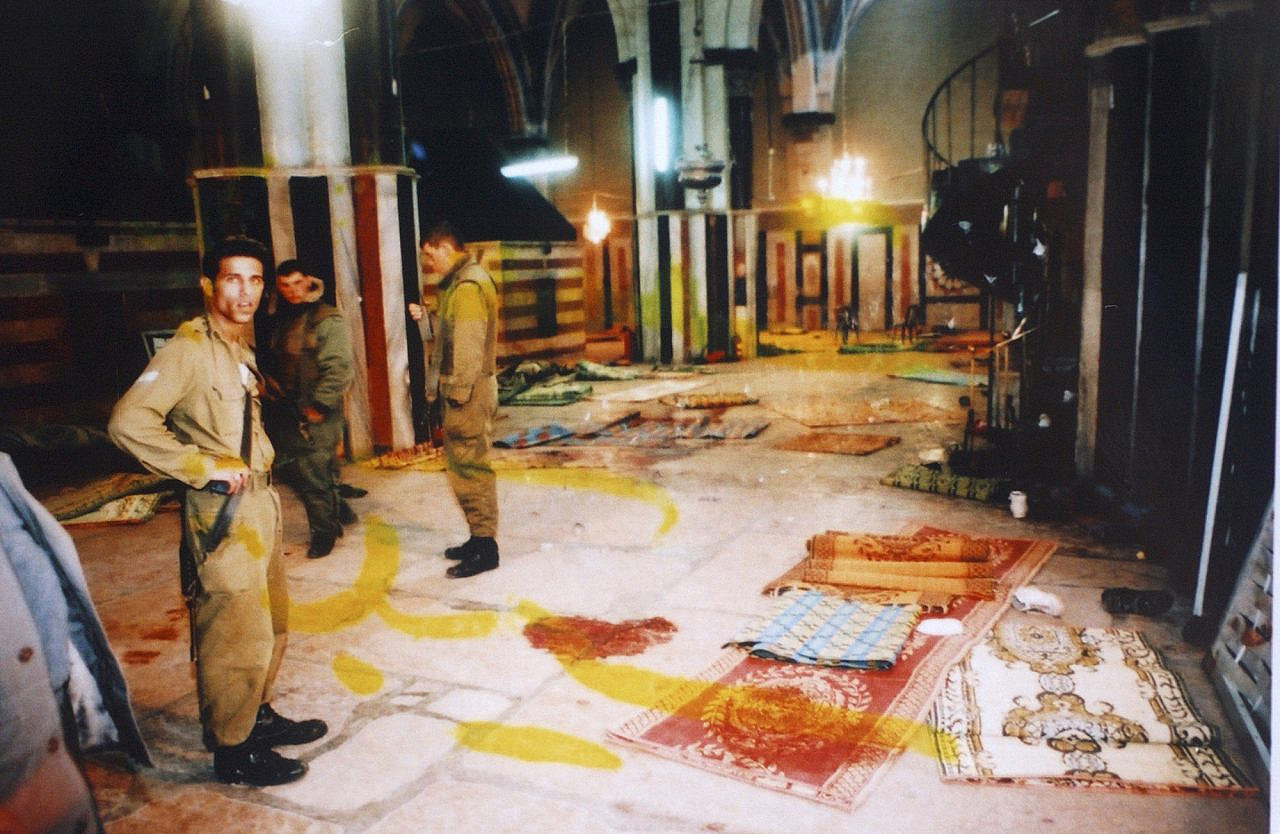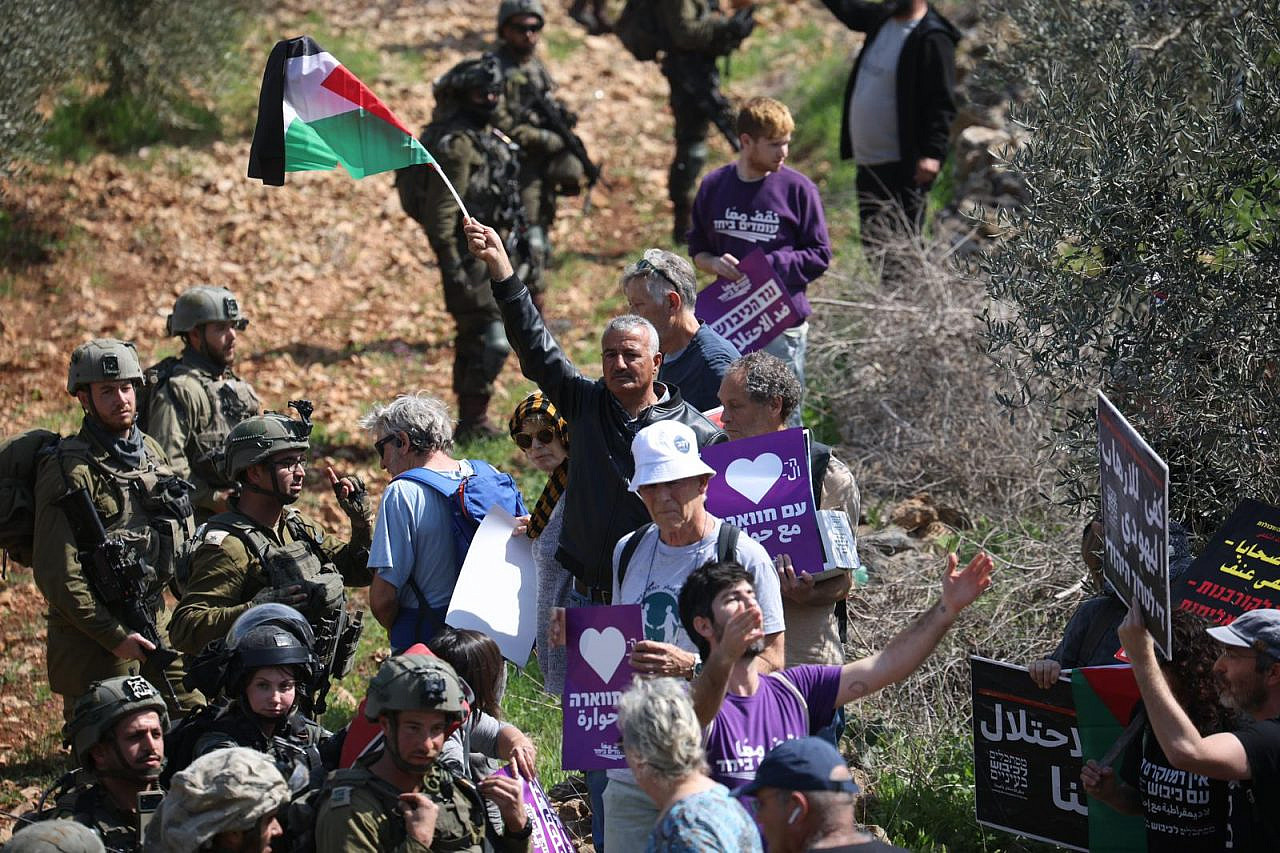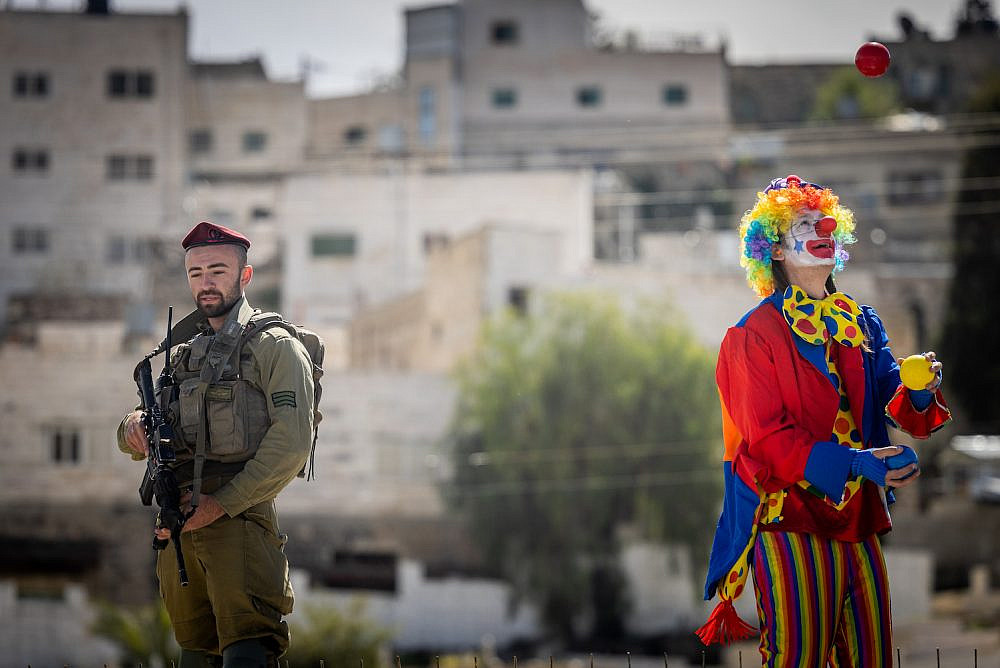On the evening of Feb. 26, several hundred Israeli settlers invaded the Palestinian village of Huwara. They set fire to dozens of cars and homes, murdered livestock and pets, and injured over 100 local residents — all under the army’s protection. One Palestinian was shot dead in the nearby village of Za’atara, though it is not yet clear if he was killed by settlers or soldiers, given that both were firing at the Palestinians in the area. In light of the shooting attack that took the lives of two Israelis in Huwara earlier that day, the settlers framed their pogrom as an act of revenge, and an attempt to “deter” further attacks against Jews.
Almost exactly 29 years earlier, on Feb. 25, 1994, the American-Israeli settler Baruch Goldstein entered the Cave of the Patriarchs/Ibrahimi Mosque in Hebron, armed with a rifle. He opened fire on the hundreds of Palestinian Muslim worshippers, murdering 29 and injuring over 100 before the survivors overpowered him.
The timing of the Ibrahimi Mosque massacre wasn’t incidental: it took place on Purim, the Jewish holiday celebrating the averted annihilation of the Jews of ancient Persia by the evil royal vizier Haman. Hours after the massacre, in synagogues across the land, congregations concluded the special Purim Torah reading with a verse from the Book of Exodus declaring “a war for the Lord against Amalek from generation to generation.” Many of Goldstein’s far-right allies suggested he was doing just that, presenting the ethno-nationalist massacre of an occupied people as an act of holy war.
Goldstein’s violence and the pogrom in Huwara are just two horrific examples of a larger pattern: using the language of Jewish safety and potential annihilation to justify state and settler violence, and framing it as a means to defend ourselves against an eternal enemy. As we mark the anniversary of Goldstein’s massacre and respond to yet another act of settler terrorism, it is our responsibility as Jews not only to denounce the perpetrators of these violent acts, but to resist this warped logic of “self-defense” that serves only to legitimize the murder of Palestinians and entrench Israeli apartheid.

A pogrom to destroy Amalek
These questions of violence and defense are not new. They are, in fact, deeply relevant to this week’s Purim holiday. At the end of Megillat Esther, the biblical text that tells the Purim story, the king does not cancel the decree calling for the genocide of the Jews; instead, he authorizes them to fight back. Over the course of two days, the newly-empowered Jews slay 75,000 of their enemies.
Many Jews today feel uncomfortable with this reversal of violence, often downplaying this element of the story. But others have lauded this chapter that lies somewhere at the intersection of self-defense and revenge fantasy. Over the past millennium, some Jewish communities have even used Purim as a day to attack their Christian oppressors. And on Purim morning 29 years ago, Baruch Goldstein, a settler of a colonial state, slaughtered an occupied people as they lay prostrate in prayer.
In the years since the massacre, Jewish children have dressed as Goldstein for the Hebron Purim day parade, where settlers dance through the streets, spray paint Stars of David across the city like threats, and chant “Death to Arabs” while the city’s Palestinian residents are forcibly confined to their homes. People visit Goldstein’s grave – located in Meir Kahane Park of Kiryat Arba, the settlement next to Hebron inhabited by many of the most extreme Israeli settlers – as a type of pilgrimage. Israel’s National Security Minister Itamar Ben Gvir, a fellow Kahanist from Kiryat Arba, only recently took down a portrait of Goldstein from his living room wall.

Many settlers have used biblical language to frame Goldstein’s act of violence. They have conflated him with Mordechai, the hero of the Purim story, who was pivotal in averting the Jews’ destruction, and commemorated him as a symbol of the destruction of “Amalek.”
The concept of Amalek — a people we read about on the Shabbat before Purim and on Purim day — has held great sway within the Jewish imaginary over the centuries. The original Amalekites were those who attacked the Israelites as they fled from Egypt, cutting down the weakest and most vulnerable stragglers. Meanwhile, the villain of the Purim story, who plots a genocide of Persia’s Jews, is Haman the “Agagite,” a descendent of Amalek.
While Haman is the last explicit mention of these people in the Tanakh, the motif of Amalek recurs throughout Jewish history. Rabbinic literature and later mystical traditions render their name synonymous with a mythic, existential enemy: a nation that preys on the weak and is utterly committed to the destruction of the Jewish people.
Jews have since ascribed the label of “Amalek” to Romans, Nazis, and many oppressors in between. In the Torah, Jews are commanded to wipe out the memory of Amalek from under the heavens; the only way to avert Jewish destruction, the thinking goes, is to destroy Amalek first. And today, settlers and leading Israeli politicians routinely ascribe this label to Palestinians; just last weekend, settler groups called for a follow-up pogrom in Huwara to “wipe out the name of Amalek” by destroying the village.
Most read on +972
This framing is an extension of the widely held and frequently yielded notion that the Jewish population in Israel — and, by extension, the Jewish people as a whole — is constantly on the brink of destruction. The threat of a potential “Second Holocaust” was used by David Ben Gurion to justify the ethnic cleansing of 750,000 Palestinians in 1948, while in the years since 1967, proponents of a “Greater Israel” have described Israel’s pre-1967 borders as “Auschwitz borders” to deny any territorial concessions to Palestinians and to justify the ongoing occupation.
In this light, Goldstein’s massacre and the attack on Huwara are far from anomalous. They are a natural extension of the mainstream Israeli belief that Palestinians want to destroy Israel simply because it is Jewish, rather than understanding Palestinian opposition to the state as a natural reaction to settler colonialism and occupation. When everything is framed in terms of “self-defense” and existential threat — even coming from members of a nuclear-armed colonial power, and referring to an “enemy” that is not the mythic oppressor but the oppressed — almost any amount of violence can be justified.
A ‘radical overturning’
In the face of violence like we saw in Huwara, many Jews have a tendency to merely disassociate from it: to say “not in my name” or “this is not my Judaism,” and thus absolve themselves of responsibility. Indeed, social media and news outlets were overflowing with variations on the “No true Scotsman” trope in the aftermath of the pogrom, while comments on videos of the settlers davening ma’ariv (the evening prayer) as Huwara burned behind them declared it a desecration of God’s name and not true Judaism.
But in truth: it is Judaism. It is Judaism in the hands of a settler-colonial, Jewish supremacist ideology that will seize on any language and tradition to justify the murder and expulsion of Palestinians as holy war and protection. It is incumbent on us not simply to disassociate ourselves from the fear-mongering rhetoric and the violence that it authorizes, but rather to actively oppose it within our institutions.
This means challenging those parroting Israeli talking points about “self-defense” to justify state and settler violence, and divesting from institutions that refuse to change; it means learning about the occupation and its violence and educating those around us. For those on the ground in Israel-Palestine, it means engaging in solidarity work and supporting Palestinian civil resistance. It means giving material support to Palestinian organizing both in the land and in the diaspora. And it means pressuring governments in the diaspora to stop bankrolling the Israeli occupation of Palestine.

Divesting ourselves of this rhetoric, of state and vigilante violence hiding behind the mask of self-defense against an existential enemy, is necessary in order to build a lasting, just future. Instead of upholding the Purim story as an ideal, or even as an inevitable paradigm of how Jews must always exist under constant threat of annihilation from our neighbors, we can take the holiday’s spirit of nehafochu — “radical overturning” — to heart.
On Purim, we celebrate the sudden reversal of the Jews’ fortunes by creating a topsy-turvy day full of costume and revelry, where all one’s normal expectations are upended. This Purim, we can celebrate by envisioning a world in which the very premise of the holiday is overturned, where our mahapecha (“revolution”) generates structures of support and thriving interdependence, not war and occupation. A world in which safety stems from justice and solidarity, not destruction.
May the memories of those killed be for this revolution. Allah yerhamhom.
In Za’atara
Sameh Aqtesh – Age 37
In Hebron
Arafat Musa Burkan – Age 34
Jaber Aref Abu Sneineh Abu Hadid- Age 12
Walid Thuhair Abu Hamdiyeh Gheith – Age 14
Marwan Mutluk Hamad Abu Nijmeh – Age 31
Abdel Rahim Abdul Rahman Abu Sneineh – Age 47
Ahmad Abdullah Mohammad Taha Abu Sneineh – Age 27
Ala’ Badr Abu Sneineh – Age 17
Tareq Adnan Ashour Abu Sneineh – Age 12
Khaled Khalaweh Abu Hussein – Age 55
Mohammad Sadeq Ayoub Abu Zanouneh – Age 46
Saber Musa Katbeh Badr – Age 35
Talal Hamad Dandis – Age 24
Hatem Qader Fakhouri – Age 26
Mohammad Radi Gheith – Age 50
Mohammad Salim Idris Falah Idris Imam – Age 35
Suleiman Odeh Jabari – Age 30
Abdul Haq Ibrahim Jabari – Age 57
Zeidan Hamoudi Abdul Majid Jabber – Age 30
Kamal Jamal Kafisheh – Age 13
Diab Abdul Latif Karaki – Age 20
Khaled Hamzi Karaki – Age 19
Mohammad Kifah Abdul Mu’az Marakeh – Age 12
Nimer Mohammad Nimer Mojahed – Age 30
Wael Salah Abed Muhtasib – Age 29
Nour ad-Din Ibrahim Muhtasib – Age 20
Muezzin Jamil Ayed Abdul Fattah Natsheh – Age 50 Raed Hassan Natsheh – Age 20
Rami Arafat Rajabi – Age 12
Sufian Barakat Zahded – Age 20




